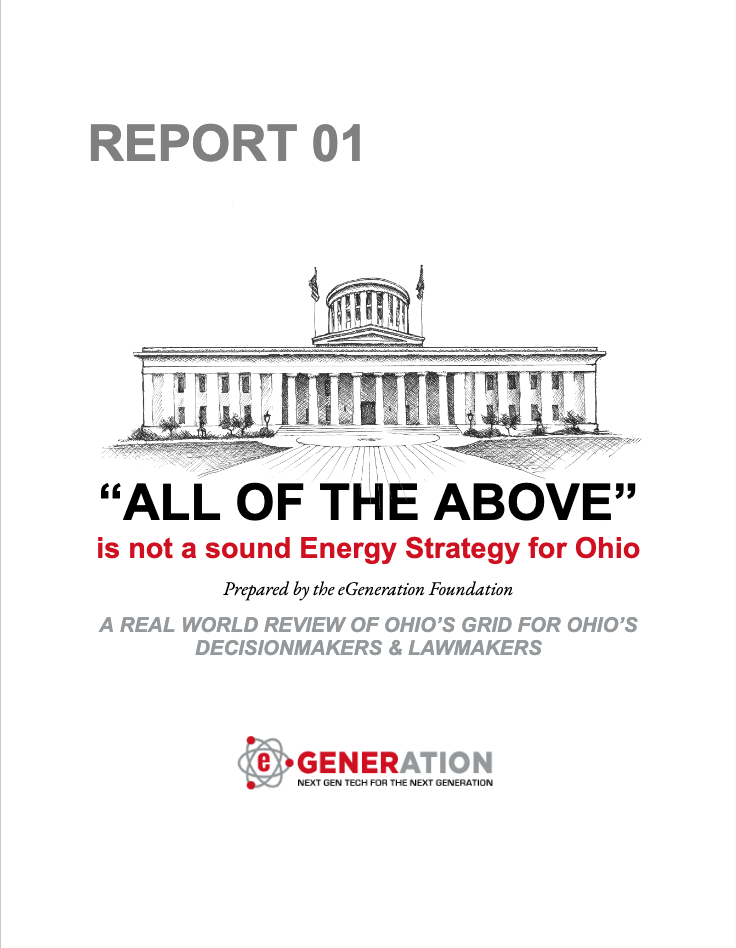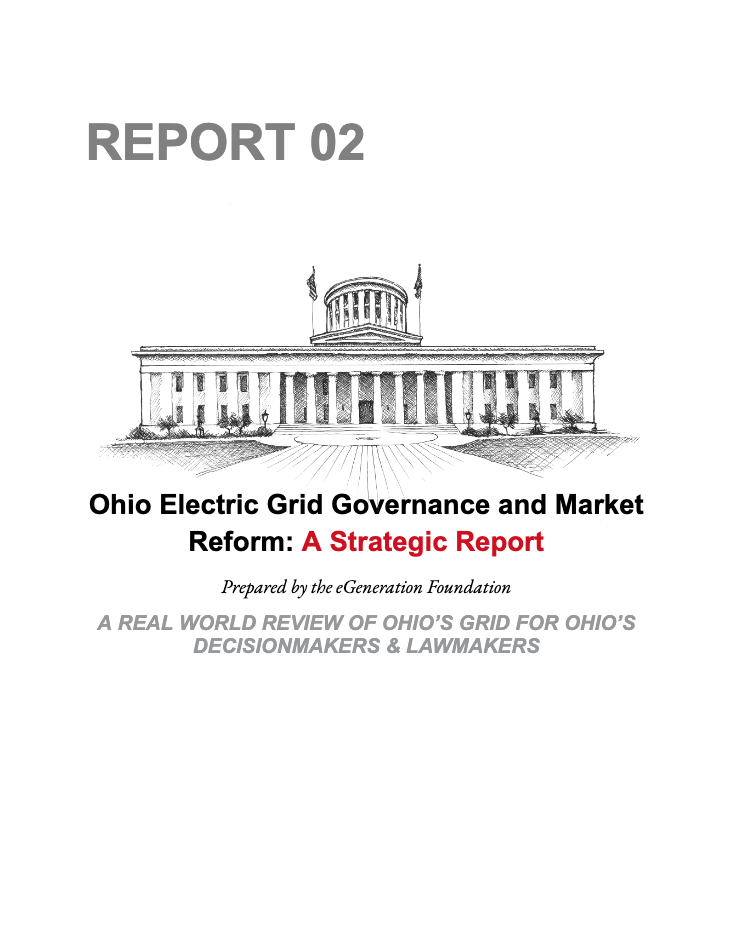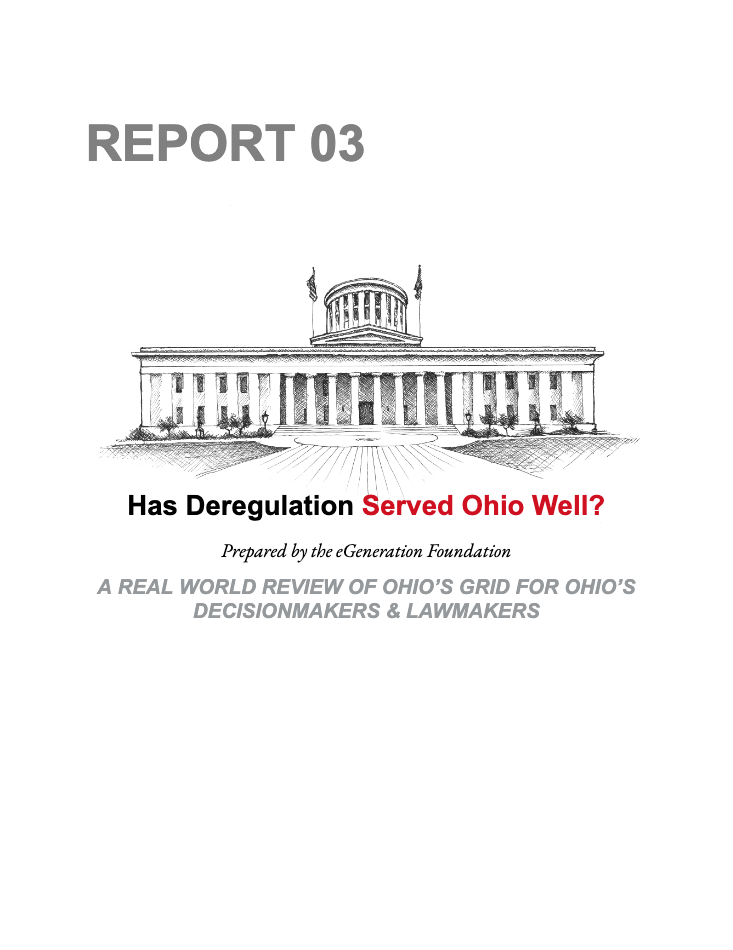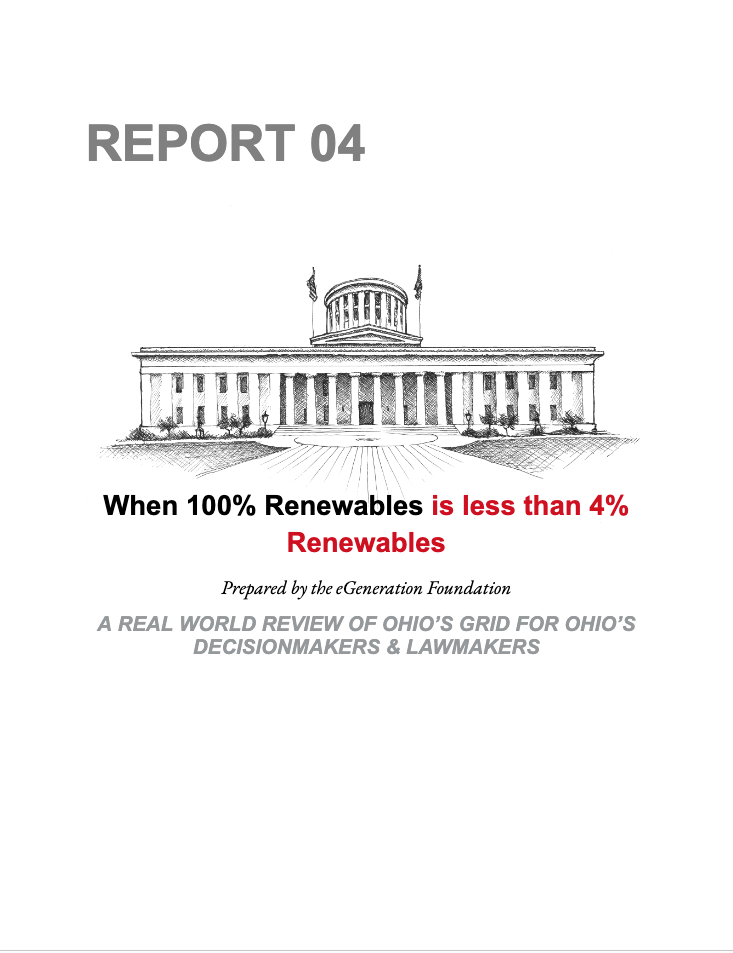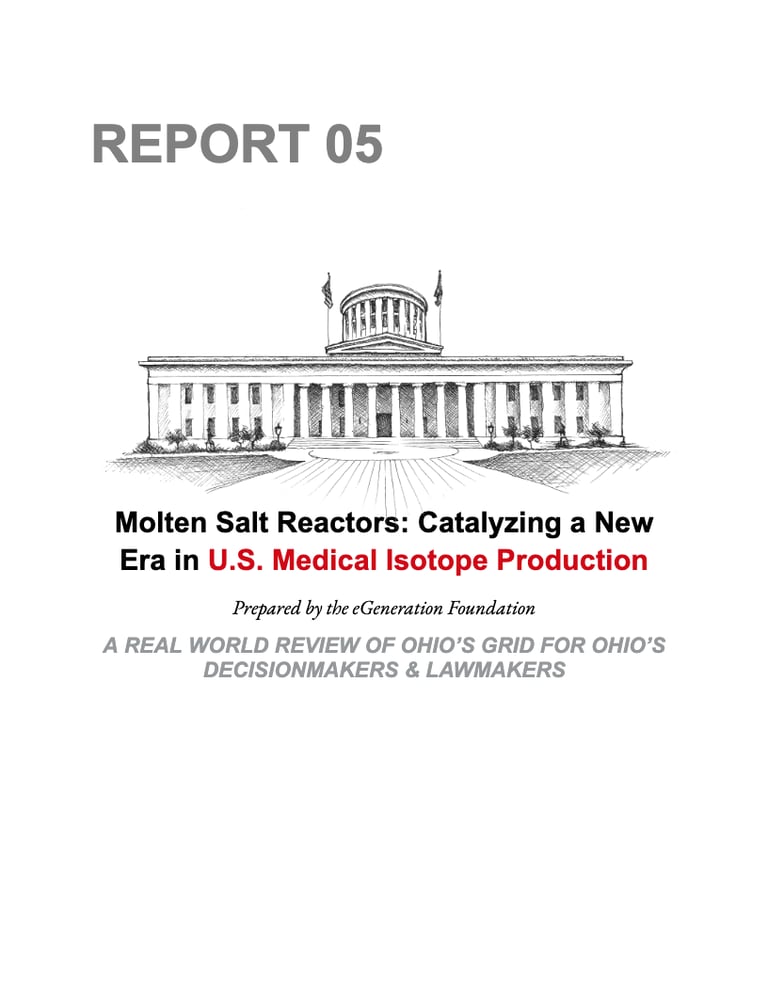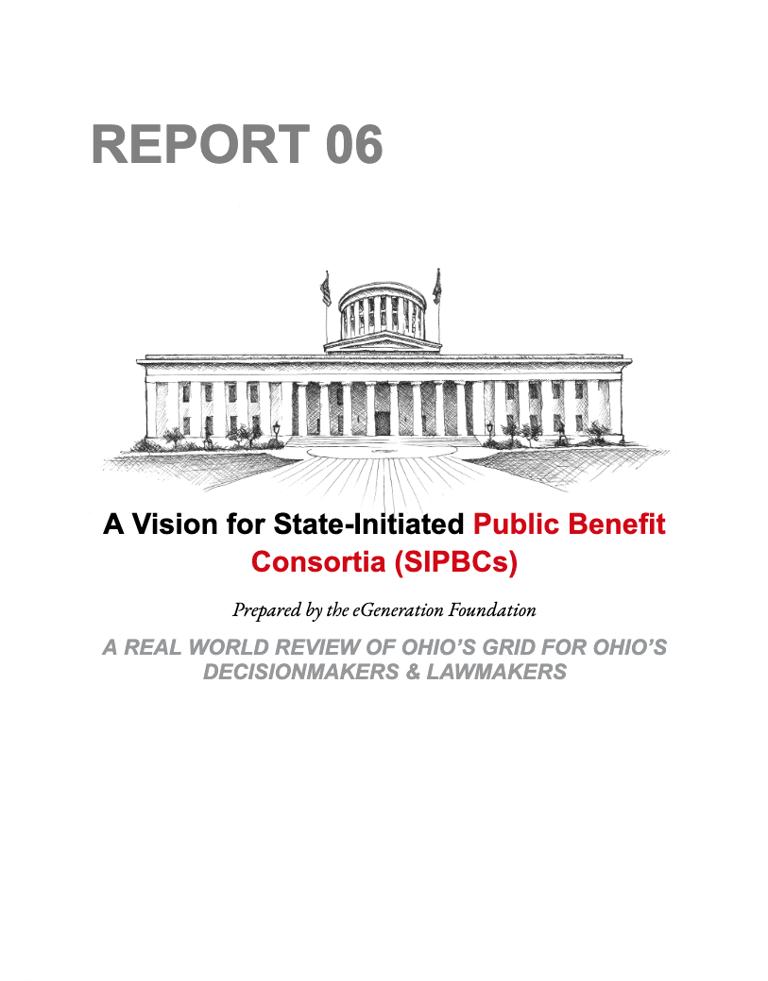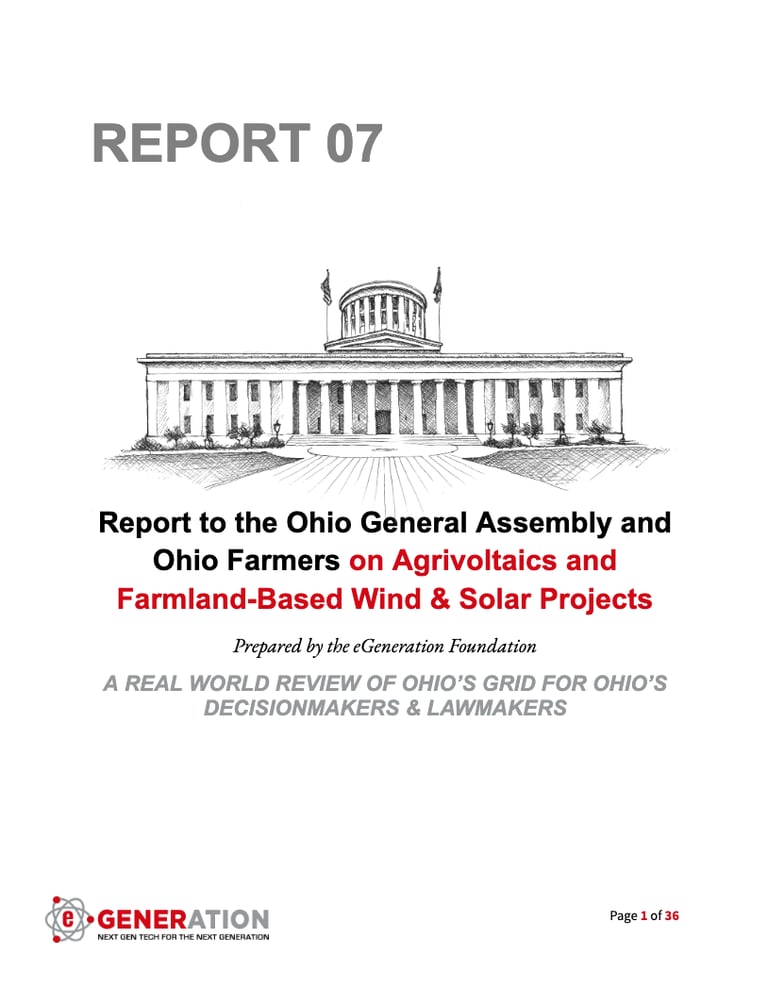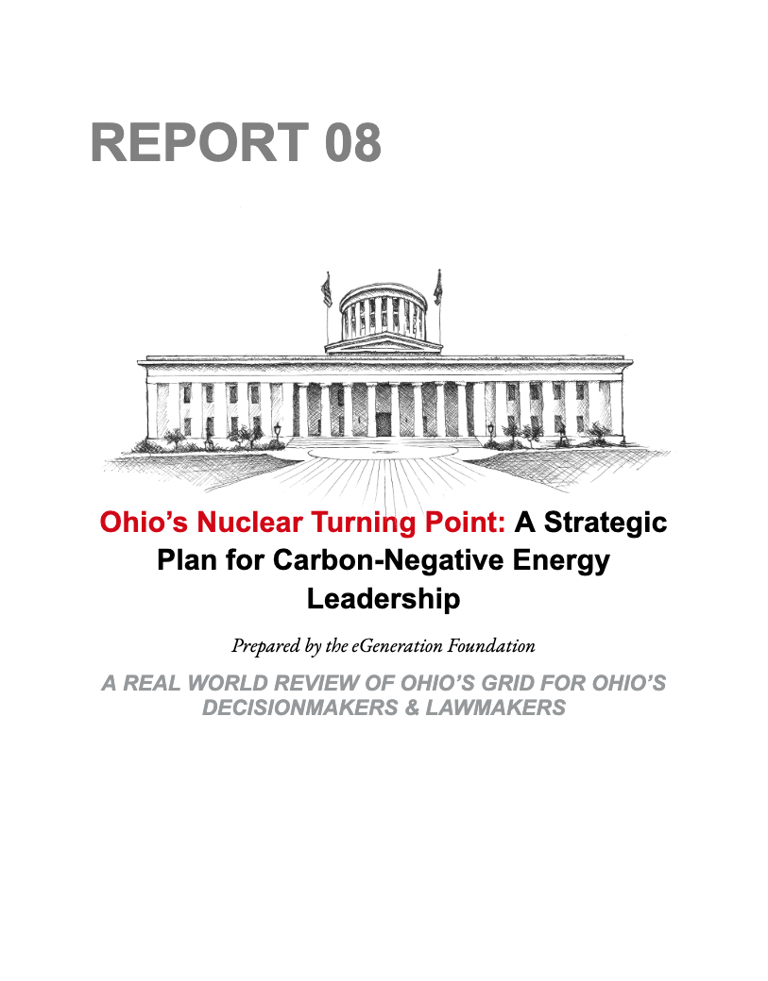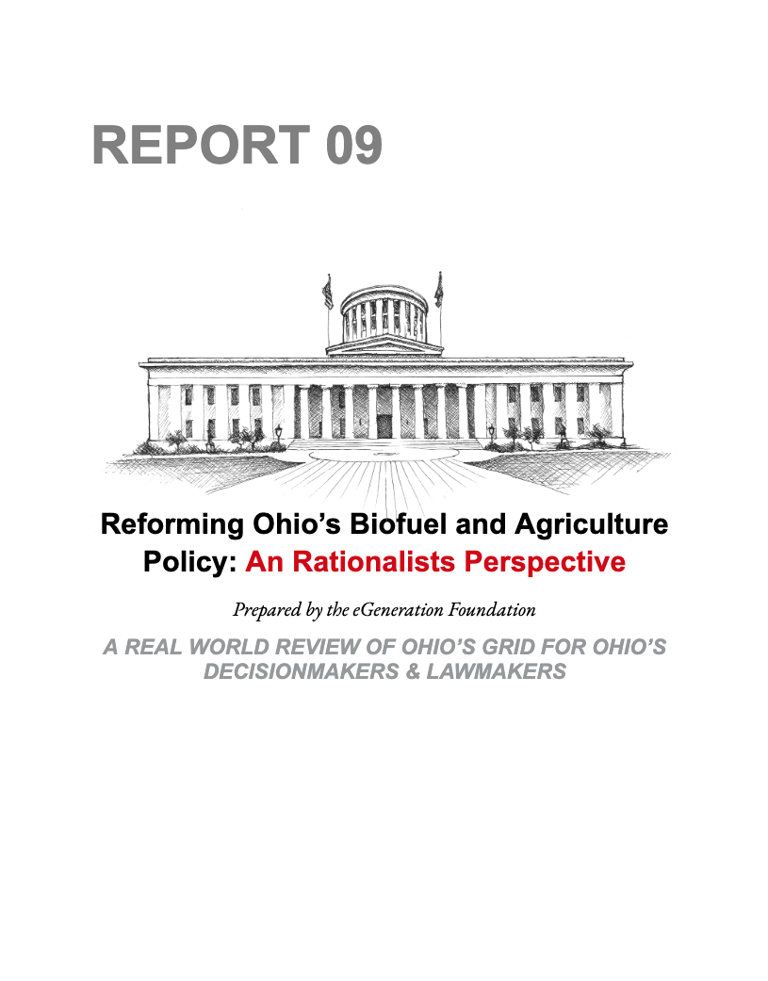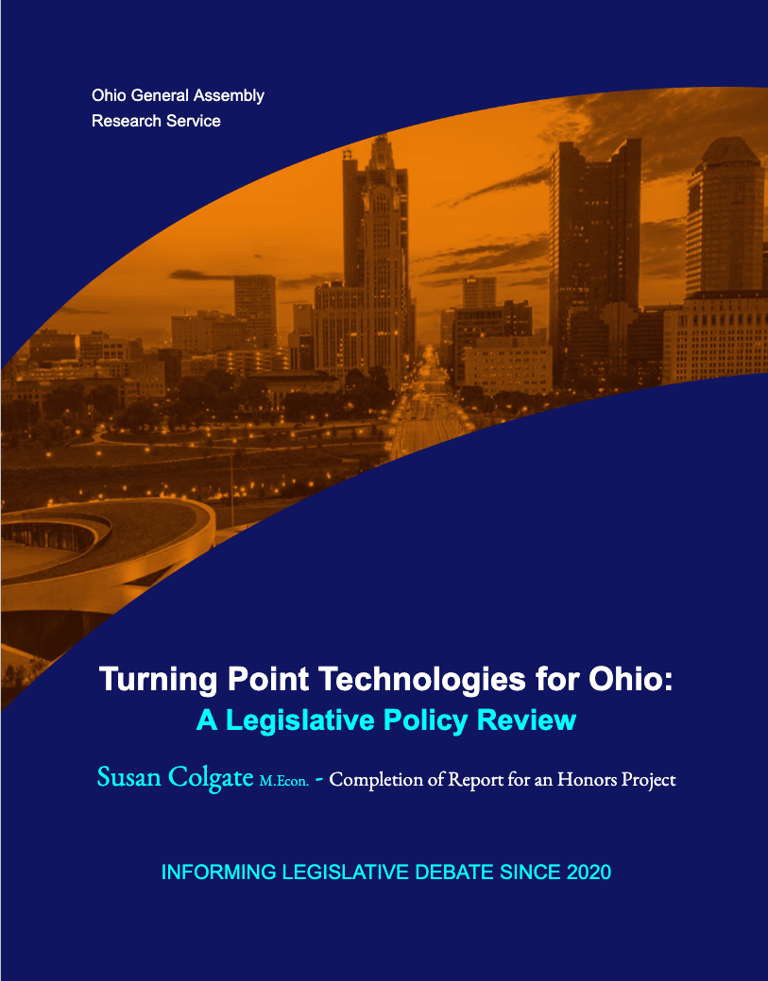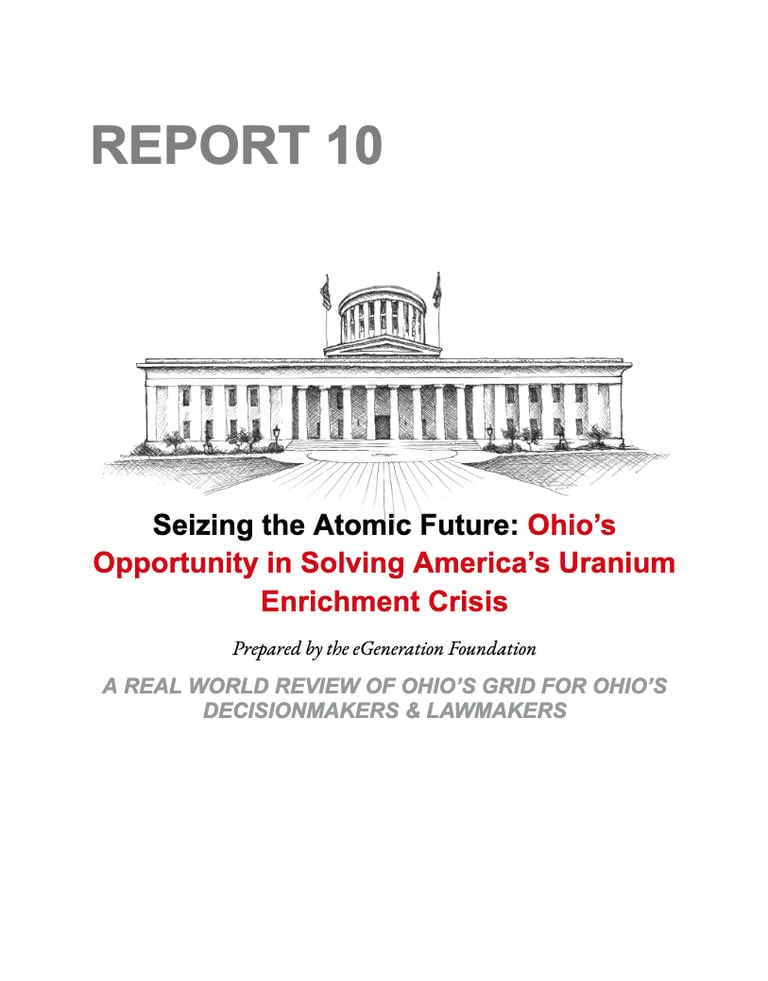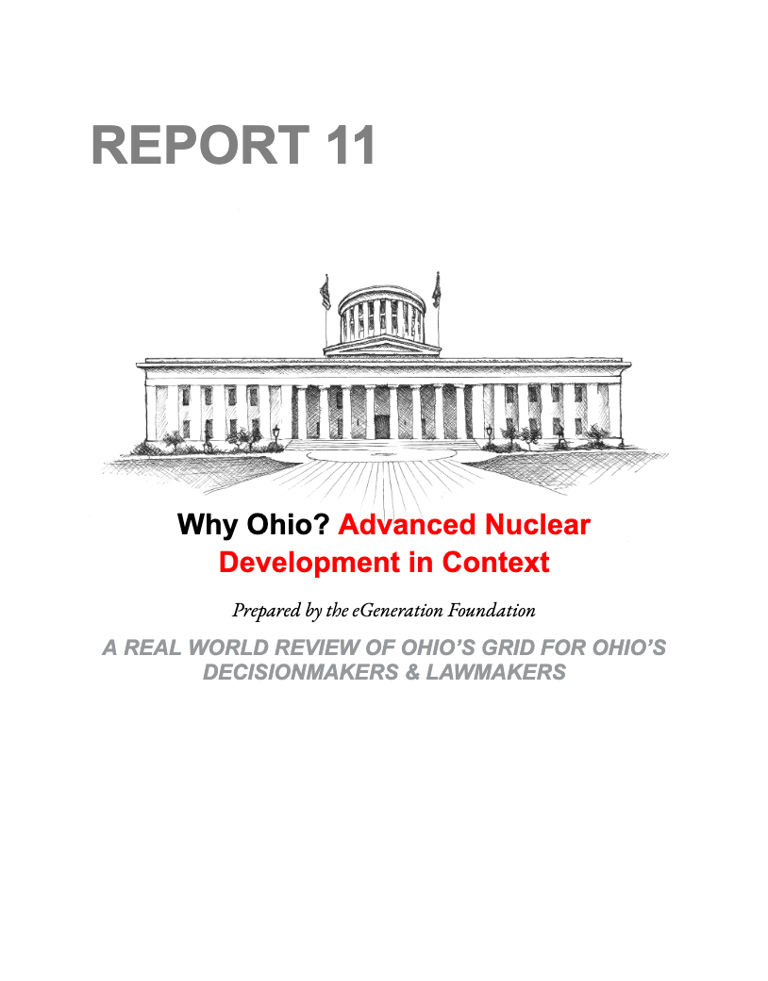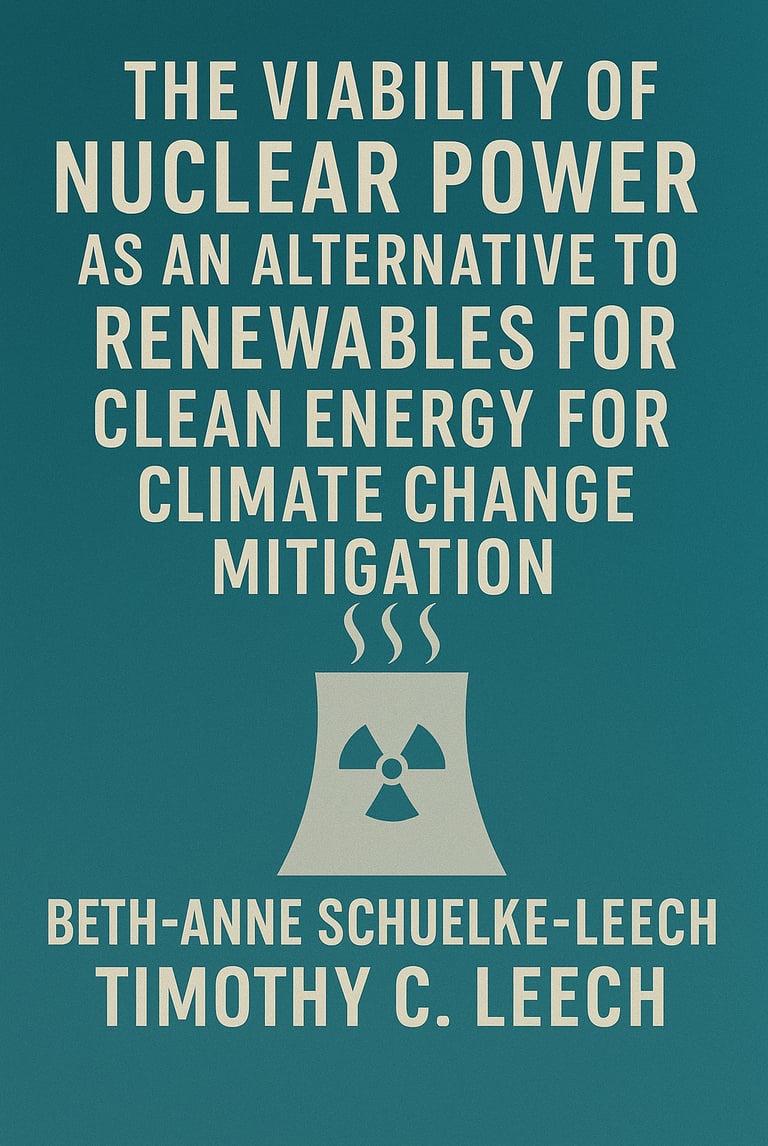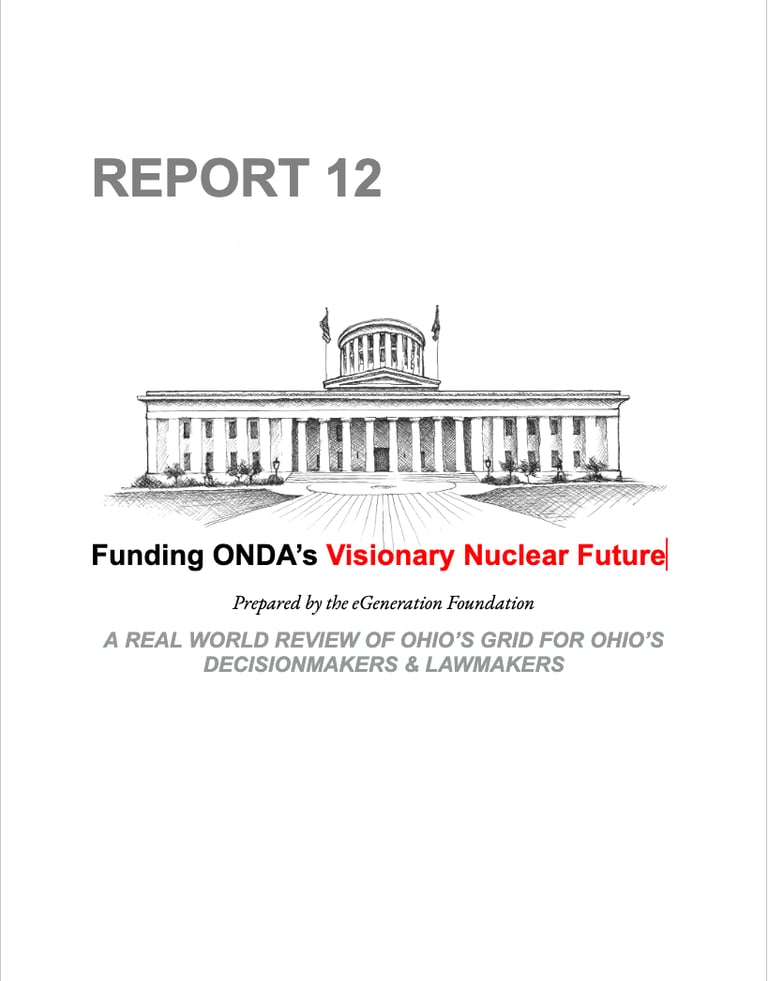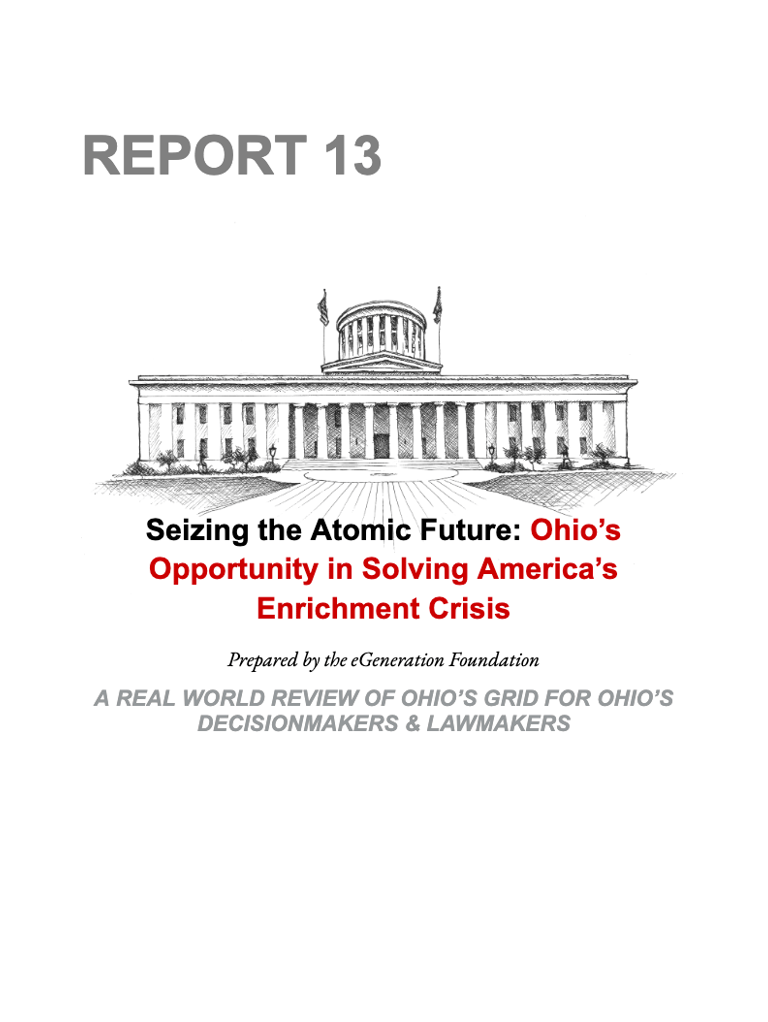OUR POLICY REPORTS
“ALL OF THE ABOVE”
is not a sound Energy Strategy for Ohio


Authored by Jon Paul Morrow M.Econ.
"ALL OF THE ABOVE" is not a sound Energy Strategy for Ohio is the first in a series of policy reports from the eGeneration Foundation. This concise yet powerful document provides a hard-hitting, data-informed critique of Ohio’s current energy planning paradigm. With clarity and conviction, it dismantles the myth of "all of the above" as a viable long-term grid strategy and offers legislators and decision-makers a rational path forward—centered on energy reliability, economic resilience, and environmental integrity. Essential reading for anyone serious about Ohio’s energy future
Ohio Electric Grid Governance and Market Reform: A Strategic Report


Authored by Jon Paul Morrow M.Econ.
This strategic report from the eGeneration Foundation delivers a comprehensive, fact-driven analysis of how Ohio's electric grid is governed and why its current market structure deserves serious scrutiny. It explores the influence of FERC and PJM, revisits the legacy of deregulation and Enron’s role, and offers side-by-side comparisons of Ohio’s electricity costs with regulated states like Tennessee and Oklahoma.
With detailed evaluations of re-regulation and the potential formation of a state-run Ohio RTO, the report weighs the economic and reliability trade-offs of Ohio regaining control of its grid. It assesses PJM's reliability during extreme weather events and examines structural biases in market rules favoring intermittent renewables over dispatchable baseload generation.
Designed for policymakers, energy stakeholders, and Ohio legislators, this document cuts through the ideology to offer a grounded path forward—one that puts Ohio’s citizens, economy, and grid stability first.
“Has Deregulation Served Ohio Well?”


Authored by Patricia Gascoyne
This authoritative report from the eGeneration Foundation provides Ohio’s legislators and policymakers with a sweeping analysis of Ohio’s electric grid performance and governance over the past two decades. Tracing the consequences of deregulation since 2001, the report confronts the erosion of democratic oversight, increased vulnerability to winter outages, and underinvestment in infrastructure. Through real-world case studies and comparisons to successful regulated states like Georgia, Tennessee, and Idaho, it makes a compelling case for reasserting state control and re-regulating the grid to foster reliability, economic growth, and technological leadership—particularly in advanced nuclear. A must-read for anyone shaping Ohio’s energy future.
When 100% Renewables is less than 4% Renewables


Authored by Miranda Morrow
This compelling report pulls back the curtain on Ohio's renewable energy claims, exposing how retail energy providers use Renewable Energy Credits (RECs) to market “100% renewable” electricity plans that, in reality, deliver less than 4% renewable energy to Ohio homes. A must-read for policymakers, regulators, and consumers alike, the document dissects the misleading marketing practices dominating Ohio's competitive energy market, challenges the economic and environmental efficacy of REC-based greenwashing, and calls for legislative reform to restore truth in renewable energy advertising. Armed with philosophical clarity and technical rigor, this report is a powerful defense of honesty in energy policy.


Authored by Gale DeForce
Molten Salt Reactors: Catalyzing a New Era in U.S. Medical Isotope Production
Imagine a world where lifesaving cancer therapies are always in stock, where advanced medical diagnostics are more affordable and accessible, and where the United States leads in both healthcare and nuclear innovation. Molten Salt Reactors and Medical Isotope Production for Ohio explores how the Buckeye State can spearhead this transformation. By harnessing cutting-edge molten salt reactor (MSR) technology, Ohio is poised to revolutionize domestic medical isotope production, ensuring national security, revitalizing its industrial base, and delivering affordable, precision healthcare across America. This bold proposal isn't just technical; it’s philosophical—a rational vision rooted in human flourishing, innovation, and American leadership.
A Vision for State‑Initiated Public Benefit Consortia (SIPBCs)


Authored by Jon Morrow
What if economic growth wasn’t a tug-of-war between public purpose and private profit, but a well-designed partnership that delivered both? A Vision for State‑Initiated Public Benefit Consortia (SIPBCs) introduces a groundbreaking model where Ohio transforms its industry coalitions into dynamic, revenue-generating ventures aligned with the free market. With JobsOhio taking a strategic maximum 9% equity stake, these consortia are engineered to solve public challenges—from energy and environment to advanced manufacturing—while operating with venture-like discipline and scalability. Drawing from the proven successes of SEMATECH, Fraunhofer, NASA, and In-Q-Tel, this proposal offers a roadmap for how Ohio can lead the nation in innovation, job creation, and strategic autonomy—one consortium at a time.


Authored by Gale DeForce
Report to the Ohio General Assembly and Ohio Farmers on Agrivoltaics and Farmland-Based Wind & Solar Projects
Beneath the glossy promises of “green energy” lies a bitter truth for Ohio’s rural communities: industrial wind and solar projects threaten the very farmland that feeds our families and anchors our economy. Report to the Ohio General Assembly and Ohio Farmers on Agrivoltaics and Farmland-Based Wind & Solar Projects exposes how these developments fragment rural landscapes, drive wedges between neighbors, and displace food production for corporate profits. Far from a win-win, the reality is a slow-motion land grab—one that rewards out-of-state developers while burdening Ohio’s farmers with long-term risks and irreparable land use changes. This report sounds the alarm: it’s time to rethink the false narrative of farmland-based renewables before Ohio trades its agricultural birthright for a mirage of energy independence..
Ohio’s Nuclear Turning Point: A Strategic Plan for Carbon-Negative Energy Leadership


Authored by Patricia Gascoyne
While the rest of the nation stumbles through half-measures and costly subsidies for intermittent wind and solar, Ohio is poised to leap ahead. Ohio’s Nuclear Turning Point lays out a bold, technologically grounded vision for turning our deepest liabilities—nuclear waste, municipal garbage, and industrial pollution—into unmatched assets: cheap, clean energy, carbon-neutral fuels, and life-saving medical isotopes. This isn’t a green fantasy—it’s a blueprint for energy abundance, industrial resurgence, and environmental restoration, powered by fast-spectrum Molten Salt Reactors and plasma gasification. Ohio has the workforce, infrastructure, and political will to become America’s clean energy engine. The rest of the country will be playing catch-up.


Authored by Miranda Morrow
Reforming Ohio’s Biofuel and Agriculture Policy: A Rationalist's Perspective
What if Ohio’s biofuel and agriculture policies have been chasing the wrong incentives, enriching middlemen while doing little for farmers, energy independence, or the environment? Reforming Ohio’s Biofuel and Agriculture Policy delivers a sharp, evidence-based critique of the status quo, exposing how well-meaning subsidies and mandates distort markets, reward inefficiency, and undermine both food and fuel security. With a clear-eyed, rationalist perspective, this report charts a path forward that re-centers policy on real productivity, innovation, and stewardship of Ohio’s land. The call is simple: stop subsidizing illusions and start investing in outcomes that work for farmers, families, and the future.
Turning Point Technologies for Ohio: A Legislative Policy Review


Authored by Susan Colgate
This comprehensive policy review presents a nonpartisan, fact-driven evaluation of Turning Point Technologies—an integrated approach combining advanced molten salt reactors with plasma gasification systems to achieve net-negative carbon emissions. The document explores how Ohio can lead in clean energy innovation, waste reduction, and economic revitalization. Designed to inform policymakers, stakeholders, and the public, this assessment offers a clear-eyed look at the costs, opportunities, and implementation strategies surrounding this bold energy paradigm.


Authored by Patricia Gascoyne
Reforming Ohio’s Biofuel and Agriculture Policy: A Rationalist's Perspective
What if the key to American energy independence, environmental renewal, and national security lies beneath Ohio’s soil? The United States faces a critical shortage of enriched uranium fuel, particularly HALEU, essential for next-generation nuclear reactors. With global tensions rising and dependency on Russian supply untenable, the time for bold, domestic action is now. This eye-opening report outlines how Ohio sits at the epicenter of the solution, with Centrus Energy’s centrifuge cascade in Piketon, visionary legislation like HB 434, and a growing ecosystem of innovation, including waste-to-fuel reactor startups like Exodys Energy. The document proposes actionable steps to launch Ohio into the forefront of nuclear innovation—reclaiming its legacy while building a carbon-free, high-tech future.
From Cold War infrastructure to clean energy powerhouse, the blueprint is here.
Why Ohio? Advanced Nuclear Development in Context


Authored by Donald Larson
Can Ohio Lead the Next Atomic Revolution?
As nations around the world adopt advanced nuclear technology to power their economies and drive their data-driven futures, Ohio stands at a crossroads. With a population and economy rivaling countries like the Netherlands—whose Petten Reactor once defined a new era in nuclear science—Ohio has the infrastructure, talent, and legacy to lead. This report examines how the Buckeye State, with its commercial reactors, research institutions, and industrial capabilities, can capitalize on the opportunity to meet the increasing electricity demands of the AI era through next-generation nuclear innovation. The question isn’t whether Ohio can rise to the challenge—it’s whether it will.


Authored by Beth-Ann Schuelke-Leech
The Viability of Nuclear Power as an Alternative to Renewables for Clean Energy for Climate Change Mitigation
Can Nuclear Power Still Innovate?
This provocative report delves deeply into the political, economic, and regulatory challenges that have stalled nuclear innovation for decades—and the bold policy shifts necessary to reignite it. Drawing on historical data, global case studies, and technological trajectories, the authors argue that genuine innovation in nuclear power will not come solely from the private sector, but from strategic, state-enabled action. If the world is serious about decarbonizing and powering the AI-driven future, it must rethink how nuclear R&D is funded, governed, and deployed.
Funding ONDA’s Visionary Nuclear Future


Authored by Jon Morrow
A Blueprint for Powering Progress with Purpose
Ohio stands at the crossroads of innovation and leadership. This report presents a bold, pragmatic plan to fund the Ohio Nuclear Development Authority (ONDA) by transforming waste into wealth. From a modest $4-per-ton surcharge on trash to a $2 billion investment from unclaimed funds—matched by private capital and potentially federal dollars—this strategy unleashes the potential of advanced reactors that consume nuclear waste, plasma gasifiers that eliminate landfills, and industries that produce clean fuels and lifesaving isotopes. By combining visionary governance with entrepreneurial tools like innovation tax credits and a public benefit corporation, Ohio can finance a future where energy policy, economic growth, and environmental stewardship work in harmony.


Authored by Miranda Morrow
Seizing the Atomic Future: Ohio’s Opportunity in Solving America’s Enrichment Crisis
As America faces a critical shortage of enriched uranium and the High-Assay Low-Enriched Uranium (HALEU) needed to power its next-generation reactors, Ohio stands uniquely poised to lead the nation into a new atomic age. Seizing the Atomic Future reveals how Ohio’s legacy infrastructure in Piketon, the pioneering efforts of Centrus Energy, and a resurgence in public-private innovation can transform the state into the epicenter of advanced nuclear fuel production. With projects like molten salt recycling, HALEU fabrication, and reactor deployment already taking shape, Ohio has the potential to solve America's enrichment bottleneck, turn nuclear waste into fuel, and attract billions in investment, while positioning itself as the backbone of America’s energy independence and clean future.
Location Info
We advocate for advanced nuclear technology development in Ohio and beyond, focusing on sustainable solutions for energy and waste management.
Ohio
123 Nuclear Ave, Ohio
Hours
9 AM - 5 PM
Contact Us for Advocacy
Reach out to support nuclear technology development and policy efforts in Ohio and beyond. Together, we can make a difference.
Connect
1234567890
Engage
info@egenerationfoundation.org

